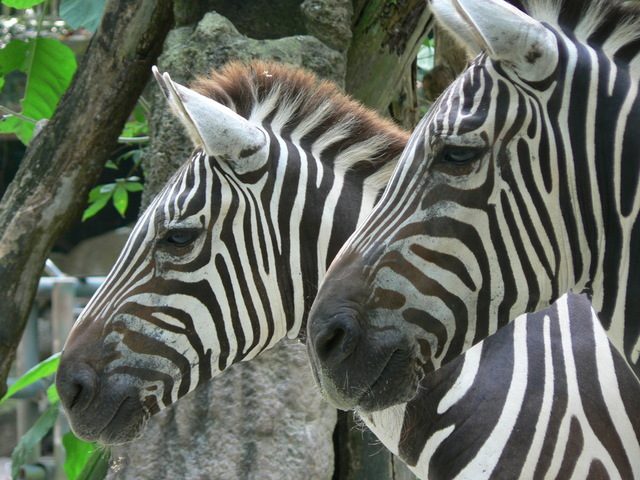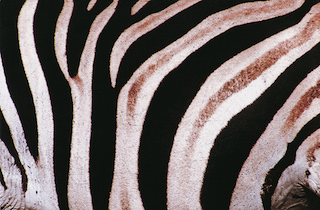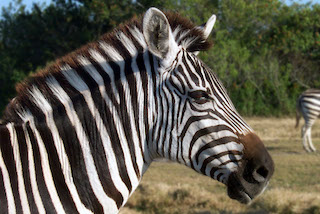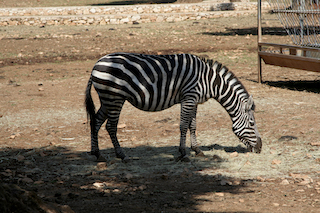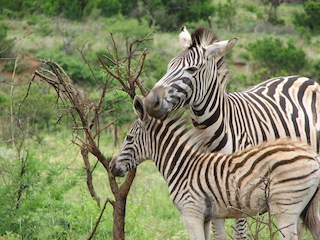- Tim Caro and Yvette Argueta: Department of Wildlife, Fish and Conservation Biology, University of California Davis, United States of America
- Emmanuelle Sophie Briolat, Maurice Kasprowsky, Matthew J. Mitchell and Sarah Richardson: Centre for Ecology and Conservation Biosciences, College of Life and Environmental Sciences, University of Exeter, Penryn Campus, Cornwall, United Kingdom
- Joren Bruggink: Aeres University of Applied Sciences, Almere, Netherlands
- Jai Lake and Martin How: School of Biological Sciences, University of Bristol, United Kingdom
Function Of African Zebra Stripes
Regarding confusion of predators, these striped animals do not have the sort of pattern that aids in confusion. African lions take zebra prey unduly suggesting an absence of confusion. Regarding camouflage, zebra stripes are not easy for lions and hyenas to resolve at any great distance. Regarding social benefits, patterns of association and rates of grooming are no greater in striped mammals than in unstriped mammals. And, there is no evidence of thermoregulatory benefits based on controlled tests using infrared images of herbivores. However, there is an emerging consensus that the primary function of contrasting stripes on zebras is to thwart attack from glossinids, tabanids and other biting muscoids. The consensus is based on comparative proof as well as field and lab tests with striped things.Confusion, camouflage, social benefits
Diseases
In Africa, tabanids carry deadly diseases including trypanosomiasis, African horse sickness, equine infectious anemia and equine influenza. Zebras are prone to these diseases because their pelage allows biting flies to probe with their mouthparts. But, speculation is that zebra stripes prevent insects from obtaining blood. But the mechanism by which this deterrence occurs is less understood. In reality, flies fail to detect zebra stripes whether from up close or from a distance because the contrasting stripes interfere with signals that promote a landing response as a result of wrong optic flow. This disrupts the finding of their host. Sadly, observations of biting flies in the areas where zebras live have so far been scant. But such information would help elucidate the phase at which stripes exert an effect on biting flies.
Field studies
Some researchers did a field studies in 2017 at the Hill Livery, North Somerset in UK. The research authors compared some behavioural measures of tabanid flies around horses and zebras living in the same habitat. Also, they compared the tabanids’ behaviour around horses wearing differently coloured cloths. They then compared the behaviour of equids in response to biting fly annoyance and reported on the amount of time that tabanids spent on these animals with different coloured pelage. The researchers studied captive zebras and evenly coloured white, brown, grey and black horses. The authors also recorded the reactions of equids to these diptera. The scholars kept the zebras and horses in separate adjacent fields. Hedges of similar width and structure surrounded the fields. In all fields, they laid out the same pasture and put out hay intermittently. They took manual records of tabanid flies and video recorded each equids both on same days. In other words, they used both video footage and direct notes.
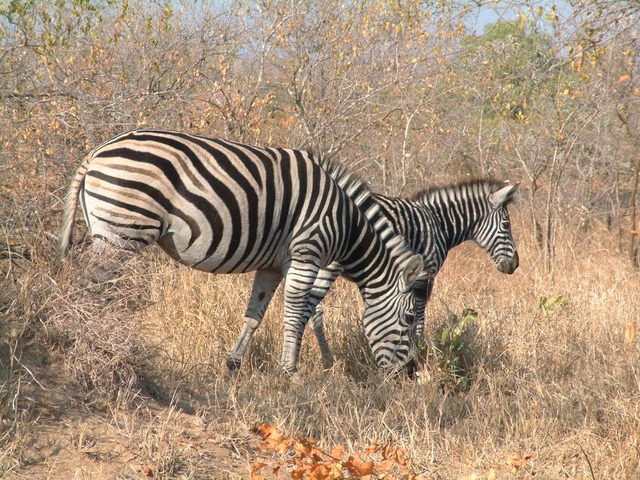
Photo by Tracy Wade from FreeImages
Study 1 involving direct observations
The total observation time of 3 zebras and 9 horses was 16.3 hours. An observer standing 1-2m distance on each side of the equid recorded the number of flies circling around, landing and touching on each host. Touching happened rapidly and consisted either of the insect’s head or dorsum bumping into the pelage, extremely brief landings or failed attempts at landing. Landings consisted of much more contact with a fly alighting for more than 2 seconds but usually for less than 10 minutes. The researchers recorded whether tabanids landed or touched the zebras on either white or black stripes. Then, turning their attention on flies that landed, they recorded the number of times that a tabanid probed for a source of blood or walked over the pelage. Probing meant as tilting the stomach up obliquely or askew by lowering the head and thorax.
Study 2 involving coats
For 30 consecutive minutes, the scholars placed 3 cloth coats on 7 horses in randomised order. The 1st cloth was a white Shires Equestrian Products One Performance sheet. The 2nd cloth was a black Rambo Optimo stable sheet. The 3rd cloth was a striped Buzz-off zebra neck coat. The scholars did not make any attempt to materially standardise the coats. The exterior surface of the coats was cool mesh, ripstop polyester and striped mesh fabric. The authors assumed that thickness of the coat would have no effect whatsoever on its pull to flies from a distance since the only structural effects of tabanid traps relate to overall trap design. Coats had different UV reflectance. White stripes reflects a lot of UV. White coat reflects a medium amount. The black coat and black stripes reflected very little. The coat covered the horse’s back, rump, flank, withers, belly and neck. But it did not cover the ears or head which were naked. Two observers always stood about 2m away. They simultaneously documented the number of flies landing on each side of the uncovered head. Animals were never in the shade but only in the open. Since the scholars did not recognise the flies on an individual basis, the same tabanid could have touched or landed on the horse many times. But there was no reason to think that this occurred according to the colour of the coat.
Study 3 involving flies on equids
The scholars gathered video tapings of 7 horses and 3 zebras. The authors used a Panasonic camera from a fixed distance of 3m. From these, the scholars recorded from the videos the amount of time that tabanids remained on each side of the equid pelage. They also noted whether host forced off the tabanid or left on its own. Then their whereabouts on 10 areas of the pelage was noted from the videos. The scholars extracted from the video recordings the tabanids’ flight paths in the areas of zebras and horses using Matlab by marking their position every 2 seconds. The custom-written zoom made possible to locate the tabanid to the best pixel, resulting in repeatable and exact tracks.
Flight paths
The scholars divided the paths into 3 sections as follows. The flight path from when the fly entered the view of the camera until it performed the 1st deceleration and turned close to the pelage of the equid was an approach. This was normally a direct flight starting from the view of the camera’s side, but sometimes contained flight loops at a distance from the equids. A climbing and direct flight away from the host thereby ending out of view of the camera was a leave. This started from the moment it manoeuvred away from the equids or took off from the animal. The period in between, when it was hovering around the animal pelage was called investigation. Speed, tortuosity and duration were calculated for the 3 segments of the path. Note that these measures were only rough as flight paths would not necessarily end in contact. And they were recorded in 2-dimension. While flight path and speed may have been influenced by approach angle relative to the camera view, flight timings were not. And, flight speeds prior to touching and landing on the hosts were determined. Then a comparison between zebras and horses was made using a linear model with fly as a fixed effect.
Study 4 involving equid behavior videos
The researchers recorded 19 different behavioural patterns shown by equids in response to the bites of flies. They used video tapings of 7 horses and 3 zebras taken in 2017 for this. Fly activity around equids can get influenced by weather conditions. So, they used data from the nearest weather office, Filton, to approximate mean heat, maximum wind gust speeds, solar rays, average windspeeds, cloud cover and relative humidity each hour that the animals were observed. These 6 factors are often closely linked. Hence, in the observations for each measure, the authors determined which of these factors was most strongly co-linked with a horse or fly behaviour. They used Spearman correlation coefficients for this. They then entered that factor as a covariate in linear models with each animal as the subject for all analyses where coats were serially placed on the same horse except in study 3. Pelage was entered as a constant factor. Analyses revealed that outer factors showed fewer significant effects on the tabanid’s behavior than expected. This may be because all the data and facts are only based from calm weather conditions. University of Bristol animal welfare and ethical review board approved the study.
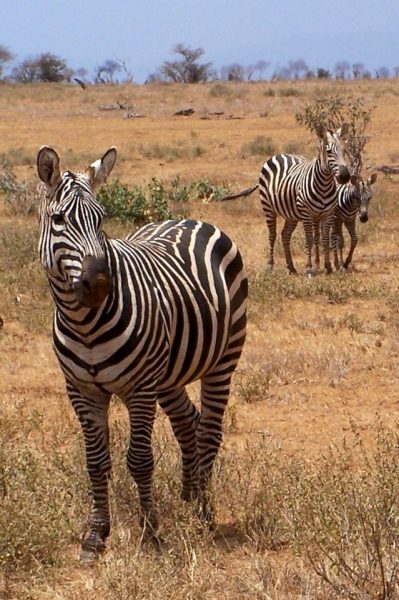
Photo by Chris Eyles from FreeImages
Results: Tabanids behavior in the equids’ vicinity
Study 1 revealed no difference in the rates at which flies circled or touched horses or zebras. Of them 54% of the tabanids landed or touched on the white stripes of zebras. Relative areas of white and black stripes for each zebra were not calculated because they were likely to be similar.
Results: Experiment with coat
To exclude any influence of differential movement or host odor in attracting tabanids, the researchers compared the number of flies landing or touching on both sides of different colored coats placed serially in random order on 7 of the horses. Rates of landing and touching on cloth coats differed. Far fewer landing and touching on striped than uniform coats. However, there were no major differences in the rate at which flies landed on the naked heads of these horses. In summary, the cloth coat of zebra had beneficial effects for the equid. But the naked head suffered more landings by the flies.
Results: Flight paths
Flies approached zebras more quickly compared to horses in terms of speed. But their tortuosities were similar. Flies spent more time investigating horses than zebras and flew away faster from zebras than from horses. Also, the flies approaching zebras did not decelerate in a controlled fashion towards the flight trajectories. But they decelerated before touching or landing on horse pelage. Moreover, tabanids often simply bumped into zebras. However, they failed to fly away or land. Data from study 1 proved that a greater number of flies touched zebras as compared to horses. Conversely, a lower proportion landed on zebras, almost 1 third fewer.
Results: Behavior of flies once on the host
Study 1 showed that if a tabanid had landed on an equid, there was no difference in the number of times in which they walked across zebra and horse pelage. But fewer probed the zebra skin than of horses. The researchers saw no fly probe the skin of zebra during a total of 5.3 hours of direct observations as opposed to 239 times in 11 hours of observation of horses. Study 3 showed that flies spent longer periods on the neck and face. And they spent lesser time on foreleg. These body parts are impossible for the animal to access with its tail or mouth. But they may also be other parts with shallow pelage. The animals forcibly removed flies using a variety of methods. The most successful methods were tail swishing and skin twitching. Interestingly, every behaviour reduced the time period that flies spent on the animal compared to them leaving on their own. The researchers found from study 3 that the amount of time that flies spent on zebras was far less. Flies spent an average of 1 second on zebras but 10 seconds on horses.
Results: Equid response to biting tabanids
Study 4 showed that unstriped and striped equids responded to tabanid annoyance using similar behavioral patterns. All animals were attended by flies to varying extents. However far more flies landed on horses. Hence, it was unsurprising that the behaviours used to rebuff tabanids were seen more in horses. And mean differences were small. Twitching were seen more in horses than in zebras. Rates of stamping, scratching and nibbling were greater for horses. This may prove the fact that the latter 2 behaviours followed tabanid departures. They were not being initiated by them. Zebras tail-flicked more than horses. And in response, they were less likely to stand still. But instead they ran away from flies or walked away briskly.
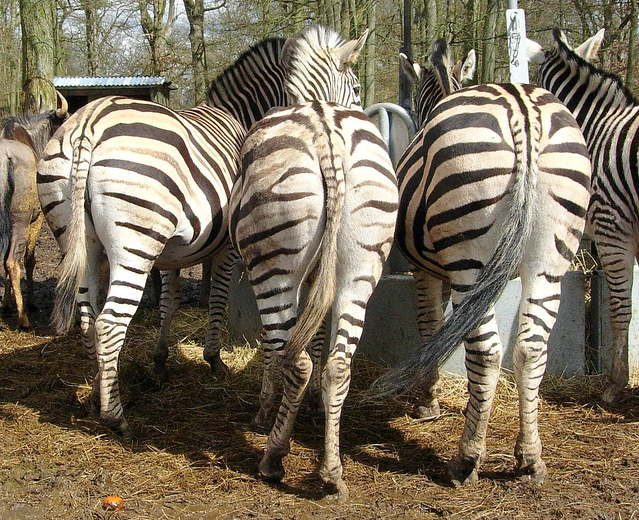
Photo by Claudia Meyer from FreeImages
Getting closer to the host
Regarding the tabanids’ behavior close to their hosts, striped equids did not experience a low rate of flies circling around them. This implies that black and white stripes do not deter attraction of flies. Also, there was no difference in landing rates on horses’ heads. However, zebra cloth coats received less landings per unit time than white or black cloth coats. This infers that black and white stripes had little effect from a distance. But once close, stripes prevented landings with tabanids turning their attention to the head instead. This was not because flies were unable to penetrate the cloth.
Similarities in approach
Many flies landed on the striped coats and spent time there. UV reflectance differences could not describe these findings either. White stripes and white coats reflected UV but not black stripes. If UV attracted tabanids, the researchers would expect many tabanids on the white coat and a few landings on the black coat. On the other hand, if UV repelled tabanids, they would expect just the opposite. The authors found neither of these in their data. On the 4 horses, on an average 41.3 tabanids landed per half hour on the black coats. But only 20.3 landed on the white coats. In retrospect, the similarities in approach towards unstriped and striped objects is unsurprising.
Scent not vision
Flies are thought to use scent rather than visual cues to find hosts at a distance. They only use vision when close up. Indeed, calculations in the past suggest that tabanids are only likely to discern stripes at a distance of less than 20m. Before that it will simply look grey. However, the data of these researchers suggest that flies may only be able to detect stripes at a 2m distance because they appear relatively unaffected further away. The data also show that flies approached zebras faster than horses suggesting that as they approached, they did not slow down or else were more motivated. However, once the flies reached the host, although tortuosities and flight speeds did not differ, they spent shorter amount of time investigating zebras than horses.
Contacting the host
Rates of touching striped coats did not differ between horses and zebras. But, successful rates of landing were lower on striped coats compared to white or black coats. Also, the researchers found that flies failed to decelerate in the final stages of their flights before contacting zebras unlike the horses. In the 2nd half the flies flew faster before touching or landing on a zebra than horse inferring that they did not regard the stripes as the right surface to land. Or else they did not see the target or were confused by the stripes because it disrupted optic flow. The proportion of flies that touched zebras was greater, but the landing rates were lower than for horses. The process by which controlled landings operate in flies is unknown, but bees and fruit flies hold the image’s angular velocity on the eye constant to control flight speed. Interspersed white and black stripes are more likely to prevent these exact assessments of angular speed of objects in ways that demand further studies.
Behavior of the host
The researchers found that in addition to stripes deterring landing attempts, when a fly did land, it spent less amount of time on a zebra. This was unlikely to be because of hair color since tabanids had already landed. Instead it suggests that zebras were using behavioral mechanisms to prevent parasites feeding on them. Zebras showed higher rates of running away and tail flicking from fly annoyance than did horses. The rate of tail flicking has been high in both wild and captive zebras. But this cannot be the only cause that tabanids stayed a short time on zebras because their tails can reach only 25% of the body length. Moreover, the authors also noticed that the zebras would stop feeding if a fly circled or touched them very often and would snap at it or eventually sprint off. But the scholars did not see these behaviours in horses.
Conclusion
Multiple lines of evidence suggest that stripes prevent effective landing by flies once they are in the host’s vicinity. But it did not prevent them from coming from a distance. Also, zebras use behavioural means to prevent flies spending time on them. They did it through constant running away and tail swishing. As a result of both these behavioural and morphological defences, very few flies are able to probe for a blood meal from zebra as evidenced by the data. In closing, there are 3 additional but more speculative points.
1st point
First, the researchers discovered that the rates at which flies touched and circled a grey horse were significantly lower than for zebras. But the rate of landings did not differ. This was in contrast to the studies between horses and zebras of other colours where touching and circling rates were not different. But zebras enjoyed less landings per unit time. There is a need to do more research on grey pelage in relation to tabanid annoyance because to flies, stripes appear grey from a distance.
2nd point
Second, they discovered that there were no rate differences at which flies moved across the surface of uniform or striped coats. Since white and black stripes give off different heat loads during the day, they possibly confuse a fly if it tried to look for a capillary by thermal sensitivity. We might expect greater zebra pelage searching rates if stripes did prevent a fly from locating a capillary. However, this was never the case.
3rd point
Third, the authors saw high rates of flicking of the tail suggesting that tail flicking may be a species-level behaviour. Striping is also a species trait and that too under partial genetic control. Hence, both behavioural and morphological anti-parasite defence tools in zebras seem to be under strong choice.
Reference
Caro T, Argueta Y, Briolat ES, Bruggink J, Kasprowsky M, Lake J, et al. (2019) Benefits of zebra stripes: Behaviour of tabanid flies around zebras and horses. PLoS ONE 14(2): e021083
For a custom-made safari, please fill out the following form or simply email us on safaris@safari-center.com

